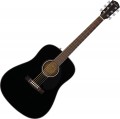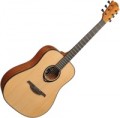Pickguard
A special protective pad that protects the soundboard from accidental contact with the pick.
The pickguard is usually located at the sound hole below the strings (if the guitar is considered in the standard playing position). With a dynamic, aggressive performance (especially when playing chords), it is in this place that the pick clamped in the hand most often hits; hitting an unprotected body causes damage to the surface of the body, which degrades the appearance and acoustic characteristics of the guitar. Pickguard prevents such damage: such an overlay is usually made of a hard material that is resistant to contact with most picks. Accordingly, the presence of this part is highly recommended if you plan to use the pick extensively when playing.
Note that the protective overlay usually differs in colour from the main material of the deck, due to which it is clearly visible.
Body
Guitar body construction, including both soundboards and sides. For these parts, two main types of wood can be used: solid (solid) and puff (better known as plywood). Plywood is cheaper than solid wood, but loses to it in terms of acoustic properties. Therefore, the type of deck in the characteristics is usually indicated only if solid wood is present in it. However, if data on the deck is not given, this does not mean that the instrument is made entirely of plywood; in addition, it is worth noting that some types of plywood come close to solid wood in terms of acoustic properties. Therefore, without having information on the deck design, it makes sense to focus primarily on the price category of the instrument.
Options for a solid tree can be as follows:
—
One piece top. The English name is also used — solid top. We are talking about instruments in which only the upper deck is made of solid wood — the rest of the body is made of plywood. This option is a good compromise between sound quality and affordable price, it is quite popular in mid-range guitars.
—
Completely whole. A body in which all parts are made of solid wood — both decks and sides. This is the most advanced option in terms of acoustics — especially since some types of wood even improve over time (provided that it is solid wood). However, a completely one-piece body is quite expensive, so this option is found
...mainly in high-end professional instruments.Scale
Scale length of the guitar. The scale in this case is the working part of the string, in other words, the distance from the saddle (on the headstock) to the saddle (on the bridge). In most acoustic and similar guitars, the scale is set during production and is unchanged. Without going into technical details, we can say that the value of this parameter is generally a reference: it allows you to some extent estimate the overall dimensions of the instrument, as well as the size of the frets (the longer the scale, the larger the size of the frets, regardless of their number). However, there is also a practical application: with an adjustable anchor (see above), the scale length data can be useful in the tuning process.

